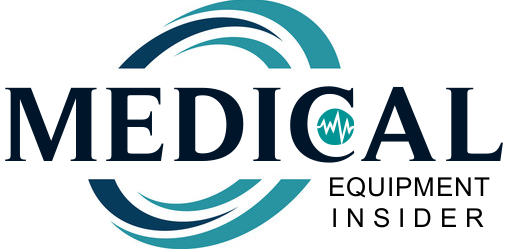Best manual toothbrush can make a real difference in your daily oral care routine, offering precise control, effective plaque removal and a gentle clean without the need for batteries or chargers.
These toothbrushes combine smart bristle design, ergonomic handles and gum-friendly materials to help you achieve a healthier smile with ease.
Whether you have sensitive teeth, receding gums or simply prefer a classic brushing experience, choosing the right toothbrush ensures a deeper clean and better oral hygiene.
In this article we highlight top picks that deliver exceptional performance and value.
What Is A Manual Toothbrush
A manual toothbrush is a handheld dental tool used to clean your teeth, gums and tongue without any powered or electric components. It relies entirely on your brushing motion to remove plaque, food particles and bacteria.
A typical manual toothbrush features a handle for grip and a head with nylon or soft bristles designed to reach different areas of your mouth.
Manual toothbrushes are affordable, widely available and easy to use, making them a dependable option for everyday oral hygiene.
What To Consider When Buying Best Manual Toothbrush
Consider the following when buying best manual toothbrush;
1. Bristle Firmness
Soft or extra-soft bristles are generally recommended because they clean effectively without damaging gums or enamel. Look for rounded or tapered bristle tips, which are gentler on gums and more effective at reaching around the gumline.
2. Head Size and Shape
A compact head makes it easier to reach all areas, especially the back molars. The shape (e.g., round, angled) matters — an angled or tapered head can help clean tricky spots more thoroughly.
3. Handle Design
Look for a handle that fits comfortably in your hand and offers good grip. Ergonomic or non-slip designs are ideal. Some handles are flexible or slightly bent, which helps when brushing at different angles.
4. Durability & Hygiene of Bristles
High-quality bristles (e.g., Nylon) dry quickly and resist bacterial buildup. Consider brushes with dense tufting or special bristle patterns (like crisscross or multi-level) for effective plaque removal.
5. Certifications & Safety
Look for toothbrushes with reliable quality seals or standards (e.g., ADA Seal) to ensure safety and effectiveness. Check that bristles meet safety standards, very thin or poorly made bristles can be harmful.
6. Replacement Frequency
Replace your manual toothbrush every 3–4 months or sooner if bristles are fraying. Worn bristles can reduce cleaning efficiency. A reminder indicator (e.g., fading bristle color) is a helpful feature for many users.
7. Additional Features
Some brushes include a tongue or cheek cleaner for added hygiene. For eco-conscious buyers, look into bamboo or sustainable-handle toothbrushes
Best Manual Toothbrush
1. NIMBUS Extra Soft Toothbrushes

If you have sensitive teeth, receding gums or just want super-gentle care, the NIMBUS Extra Soft Toothbrush offers a premium clean with micro-fine bristles designed by a periodontist.
Built with two-tier tapered bristles to reach tricky areas without damaging delicate gum tissue, this brush balances softness and effective plaque removal.
Features
- Durable design
- A 5-pack with assorted colors
- Long, extra-fine tapered bristles
- Very fine PBT fibers
- Comfort-engineered handle
- Individually wrapped pack
Pros
- Absorb less water and resist breakdown
- Created by a periodontal specialist
- Ideal for people with sensitivity or gum recession.
- The tapered bristles can get into hard-to-reach areas.
- Bristles don’t deform easily
Cons
- May require more strokes or effort for deep cleaning.
2. Colgate Slim Soft Gliding Tips Toothbrush
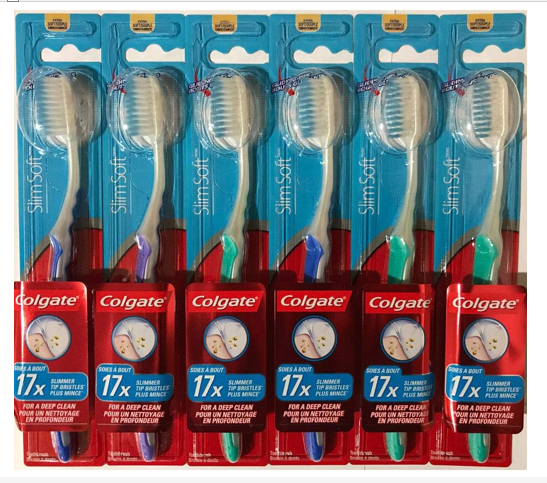
Coming in second is the Colgate slim soft gliding tips toothbrush which is perfect for people with sensitive gums or tight interdental spaces.
Its ultra-soft bristles and slim, tapered head deliver a gentle yet effective clean, while the flexible neck and gliding-tip design help you reach hard-to-access areas without irritating delicate gums.
Features
- Flexible neck
- Ultra-soft bristles
- 17× slimmer tip bristles
- Gliding tips technology
- Compact head design
- Built-in polishing cups
- Cheek and tongue cleaner
- Thin, soft-grip handle
Pros
- Comes in a set of 6
- Ideal for sensitive gums or receding gum lines.
- Slim bristle tips reach tight spaces between teeth.
- Compact head improves reach to back teeth and tricky areas.
- Flexible neck helps adapt to different angles in your mouth.
- Polishing cups brighten your smile without harsh scrubbing.
- Tongue and cheek cleaner adds extra hygiene.
Cons
- Because bristles are ultra-thin, they may wear out faster than stiffer brushes.
3. Navona Disposable Toothbrushes
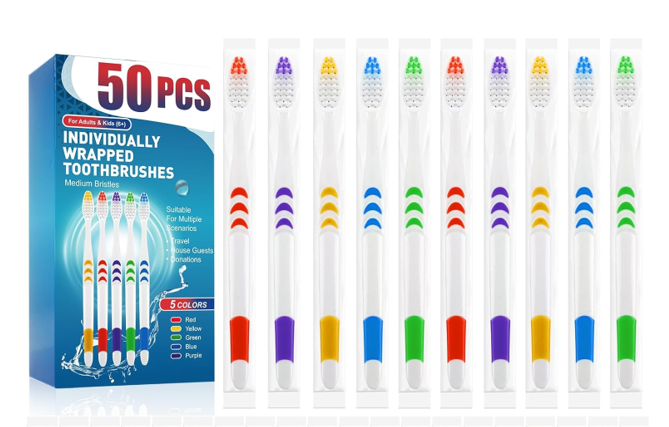
If you want a practical, hygienic solution for travel, guests, or donation drives, the Navona 50-piece individually wrapped bulk toothbrush pack hits the mark.
It is ideal for keeping things clean and convenient whether you’re on the go or stocking up for an event.
Features
- Ergonomic handle
- Assorted colors
- Individually wrapped toothbrush
- Medium-soft bristles
Pros
- Cost-effective
- Comfortable for most users.
- Ideal for single or limited use.
- Perfect for events and giving
- Different colors make it simple to assign or track brushes.
Cons
- Not for long-term daily brushing.
4. Curaprox CS 12460 Velvet Soft Toothbrush
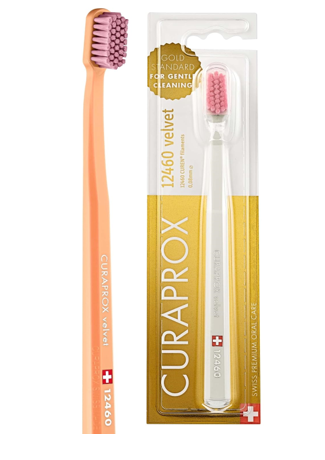
Fourth on the list is the the Curaprox CS 12460 Velvet that offers an incredibly soft, dense brushing surface that’s kind to sensitive gums and enamel yet still effective at plaque removal.
Features
- 12,460 ultra-fine filaments
- Velvet-soft cleaning surface
- Compact, angled brush head
- Octagonal handle
- Water-resistant Curen® filaments
- No BPA, phthalates, or azo dyes.
- 36 color combinations
Pros
- Exceptionally gentle
- Highly effective plaque removal
- Offers mindful brushing experience
- Long-lasting bristles
- Stylish and functional
- Filaments don’t absorb water
Cons
- Higher cost than standard soft toothbrushes
5. GREENZLA Kids Bamboo Toothbrushes
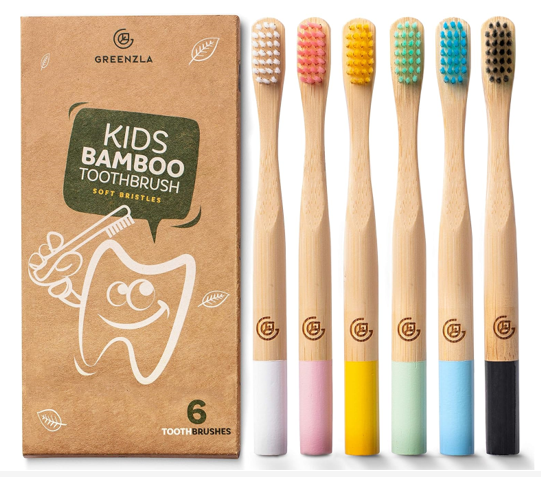
For eco-conscious families looking to replace plastic toothbrushes with something greener and kid-friendly, the GREENZLA kids bamboo toothbrushes are a fantastic pick.
These brushes feature compostable bamboo handles, soft charcoal-infused bristles, and a design tailored for children while helping build healthy brushing habits while reducing environmental waste.
Features
- BPA-free
- Ergonomic design
- Kid-sized
- Natural bamboo handles
- Charcoal-infused soft bristles
- Compostable, zero-waste packaging
Pros
- Easy-to-grip handle.
- Long-lasting use
- Ideal for young, sensitive gums.
- Great value for a disposable brush.
- Lightweight and ergonomic
- Offers a 100% satisfaction guarantee
Cons
- Drying required after use
6. MOUTHWATCHERS Manual Toothbrush Set

The Mouthwatchers soft flossing toothbrush is a thoughtfully designed manual brush by Dr. Ronald Plotka that mimics the feel of flossing while you brush.
With super-fine, extra-soft bristles and silver-infused polyester, it reaches deep into the grooves and between teeth making it especially suited for those with sensitive gums or who want a gentler, more thorough clean.
Features
- Silver-infused bristles
- Dual-layer bristle design
- Floss-like ultra-thin bristles
Pros
- Backed by dental expertise
- Long-Lasting Brush
- Penetrates hard-to-reach areas
- A 6-pack with assorted colors
- Built specifically for sensitive teeth and gums
Cons
- Polyester bristles are not biodegradable.
Types Of Manual Toothbrush
The following types of manual toothbrushes are common;
- Soft Bristle Toothbrushes – Recommended by most dental professionals. Gentle on gums and enamel while effectively removing plaque. It is ideal for people with sensitive teeth, gum recession, or post-dental surgery.
- Medium Bristle Toothbrushes – Slightly firmer than soft bristles. Provides more scrubbing power but can irritate gums or wear enamel if used aggressively. Best for users with healthy gums who want more mechanical cleaning action.
- Hard Bristle Toothbrushes – Rarely recommended by dentists. Very firm; can remove surface stains but may damage gums and enamel over time.
- Children’s Toothbrushes – Smaller heads, softer bristles, and ergonomic handles for little hands. Fun colors or designs encourage kids to brush regularly.
- Interdental or Flossing Toothbrushes – Extra-fine bristles, sometimes arranged in unique patterns to reach between teeth. Mimics flossing while brushing.
- Specialty Toothbrushes – Includes angled, multi-level, or crisscross bristle designs. It may feature tongue scrapers or polishing cups for enhanced cleaning.
- Eco-Friendly / Bamboo Toothbrushes – Handles made of bamboo or compostable materials. Bristles usually soft nylon; focus on sustainability without compromising cleaning efficiency.
Precautions When Using Best Manual Toothbrushes
Consider the following precautions when using the best manual toothbrushes;
- Use Gentle Pressure – Brushing too hard can damage enamel and irritate gums, even with soft bristles.
- Replace Regularly-Replace your toothbrush every 3–4 months or sooner if bristles are frayed. Worn bristles reduce cleaning effectiveness and can harbor bacteria.
- Proper Brushing Technique – Hold the brush at a 45° angle toward the gumline and use small, circular motions instead of aggressive back-and-forth scrubbing.
- Keep Toothbrush Clean – Rinse thoroughly after each use and store upright to air dry. Avoid covering the brush or storing in closed containers while wet, as this encourages bacterial growth.
- Avoid Sharing – Never share toothbrushes; this can transfer bacteria and increase the risk of infections.
- Mind Sensitive Areas – Be extra gentle around receding gums, exposed roots or after dental procedures. Consider ultra-soft or specialty brushes for sensitive teeth.
- Check for Allergies – Ensure the bristle material or handle does not cause irritation or allergic reactions.
- Supervise Children – Young children should be guided to brush properly to avoid choking hazards or swallowing toothpaste.
FAQs For Best Manual Toothbrush
How often should I replace my manual toothbrush?
Replace it every 3–4 months or sooner if the bristles are frayed. Worn bristles clean less effectively and can harbor bacteria.
Should I use a soft, medium, or hard bristle brush?
Soft bristles are recommended for most people as they clean effectively without damaging gums or enamel. Medium or hard bristles may cause irritation or enamel wear.
How should I brush properly with a manual toothbrush?
Hold the brush at a 45° angle to your gumline and use gentle circular motions. Avoid aggressive back-and-forth scrubbing to prevent gum recession.
Can I share my manual toothbrush with family members?
No. Sharing toothbrushes increases the risk of transmitting bacteria and infections. Each person should use their own brush.
How do I keep my toothbrush clean and hygienic?
Rinse thoroughly after each use, store upright to air dry, and avoid covering it while wet. Replace regularly to maintain hygiene.
Conclusion
Choosing the right manual toothbrush is essential for effective oral care, whether you prioritize soft bristles, ergonomic handles, or eco-friendly materials.
With proper brushing technique and regular replacement, the best manual toothbrushes can help prevent plaque buildup, protect gums, and maintain healthy teeth.
From children to adults and sensitive-tooth users, there’s a high-quality option for everyone. Investing in a reliable toothbrush not only improves daily oral hygiene but also supports long-term dental health, making it a simple yet powerful step toward a healthier smile.
